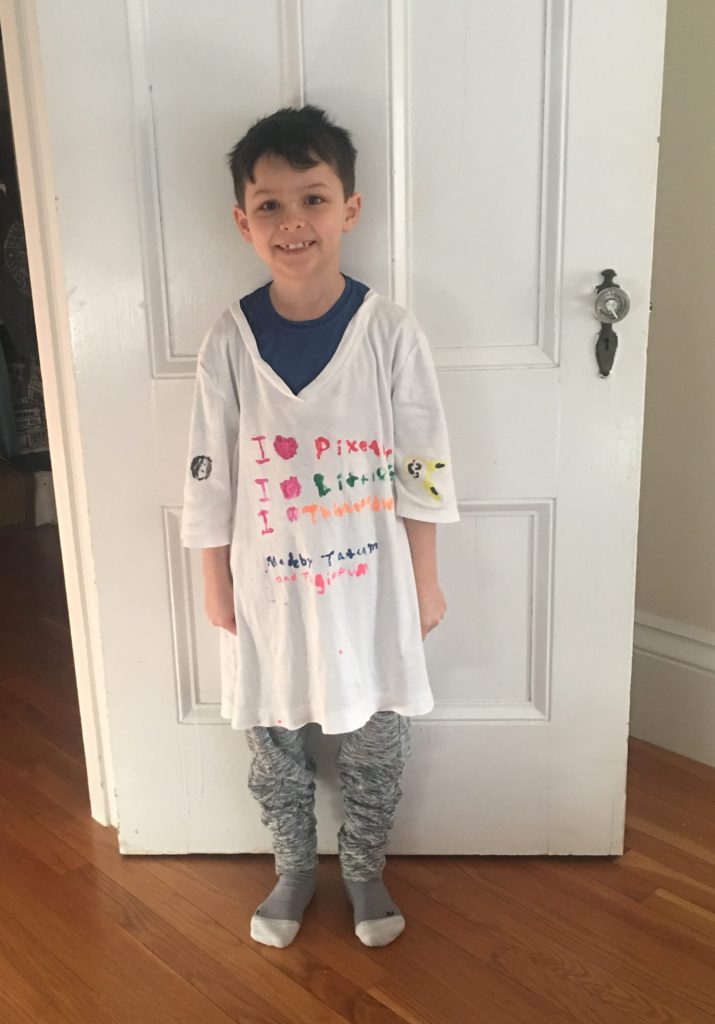That time my son rediscovered crafts
/So far in his relationship with crafts, Sonshine has regarded them with a range of emotions. On one end of the Posture Toward Doing Crafts spectrum was a feeling of Ambivalence as demonstrated by a screwing up of the side of his mouth and a shrug, "Like, do you think we can actually go eat a Nutty Bar instead of doing this craft?" On the other end of the spectrum is something I would characterize as Existential Angst, like, "What is a craft and why does it benefit me, you, the community-at-large, if I glue this googley-eye to this popsicle stick and then wait for it to dry, subsequently discarding it as waste in the days to come?" This range has been replaced with one that includes a much warmer zone, a climate where temperatures might even reach Craft Ecstasy?
I know. It's been a confusing time for me, too.
It started when Sonshine started begging nagging harassing asking me for a white T-shirt. He didn't specify a reason. A small ask by any measure, and although I am sure he wasn't envisioning the woman's JJill white XL T-shirt when he requisitioned the plain white T, he seemed pleased as punch when we scored it for a whole two moneys at Boomerangs thrift store over spring break. Achievement level unlocked!
When we got home and he started asking me for the paints, however, this is when I started to take his temperature, and just asked casually if I could see his dental records. WHO THIS.
The boy set about to decorate the official t-shirt of the Vera Bradley luggage-toting mom with some verbiage that is not completely familiar to me. It would appear, given the primitive YouTube graphic rendering on the back, that the T-shirt is basically an homage to all of the YouTube stars du jour who know Things about Minecraft. I mean, I get it. I wore a Paula Abdul "Forever Your Girl" tour shirt for a minute. I know what it is to wear your fandom on your literal sleeve.
In the meantime, the boychild also produced a puppet that, I would assume was pulled from the Upside Down, but is, once again, some kind of homage to a YouTuber du jour.
I don't know what your alarm clock sounded like yesterday, but I'd be interested to know if you've ever been roused from sleep with: MOM CAN YOU PUT THIS ON TWITTER LIKE RIGHT NOW I NEED TO SHOW THIS TO PIXELDIP AND SEE IF HE WILL GIVE ME A SHOUTOUT MOM MOM MOM TWITTERRRRR.
![]()
So I guess you could say things are getting pretty serious.
Back to the t-shirt, though. Upon completion of this t-shirt craft involving puff paint (like this was the year 19 freaking 91), Sonshine launched his campaign to get said apparel washed, dried, and wearable so that at 600 hours this morning, he was all-systems go.
"I just hope the kids at school aren't distracted."
Yeah, I mean. I don't see why they would look twice at a kid who appears to have shoplifted from JJill and then gotten dressed in the ballpit at McDonald's Playland.


Craft on, players.

 which just released in the last week. I've already delved into it and even though this book primarily offers guidance for parents of daughters, there is one chapter that has universal appeal for women.
which just released in the last week. I've already delved into it and even though this book primarily offers guidance for parents of daughters, there is one chapter that has universal appeal for women.